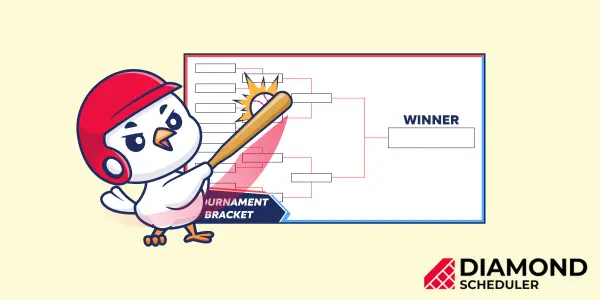
Exploring 14-Team Double Elimination: Unveiling the Babe Ruth League
There's not much in this world that comes close to the excitement that you get from watching your favorite team battle through the most important tournament of the season. All the blood, sweat, and tears that have surmounted these crucial do-or-die matches. The thrill and agony is unmatched as you cheer your team on to victory.
As sports fans, we've all been there, but as league owners or managers, we also understand the importance of what goes on behind the scenes to bring the tournament to life for the fans to enjoy. Many challenges arise, particularly within the scheduling aspect of the business. Even seasoned owners often run into issues, but with a solid foundation and understanding of the intricacies of the tournament, league owners and managers can tackle these challenges head-on.
In this article, we will focus on a 14-team double-elimination bracket style of tournaments and the Babe Ruth League, a prominent youth baseball and softball league that utilizes this bracket style. We will also dive into the large role that scheduling software plays in managing high-level tournaments and how you can take advantage of one of the best scheduling tools available on the market today.

Understanding 14-team double-elimination brackets
To have a solid understanding of how the usual 14-team brackets work, it's important first to become familiar with double-elimination style tournaments. In a double-elimination tournament, a competitor or team must lose two games in order to be eliminated from the second round of the competition. It ensures that the ultimate victor has defeated every contender at least once by giving participants a second chance to compete even after a loss. The tournament starts with two brackets, a winner's and a loser's bracket.
All teams start in the winner's bracket, and teams that lose drop into the loser's bracket. The team that makes it out of the winner’s bracket without losing a single game goes on to the final round. Losing teams must compete in the loser's bracket, and the team that makes it to the end, having only lost one game, will compete in the final round. From there, the team from the loser’s bracket must win twice to secure the championship, while the team from the winner’s bracket must only win once more.
Benefits of double-elimination brackets
There are a good deal of benefits that come with the use of double-elimination brackets. Different sports and esports use this tournament style worldwide to drive fan engagement and promote fairness. Here's a breakdown of some of the benefits:
1. Extended opportunities for teams to recover from losses:
With the requirement of a team needing to lose two games to be eliminated, teams have more opportunities to make it to the final. Who doesn't like a good underdog story?
2. Increased fairness and reduced impact of a single upset:
Double elimination promotes increased fairness by mitigating the chance of a single upset compared to single-elimination brackets. The unpredictability of sports may cause teams that are seeded higher to lose their first game, but they and lower-seeded teams will have a second chance to prove themselves.
3. Longer tournament duration and increased excitement for participants:
This one speaks for itself, but double-elimination tournament styles bring more excitement to the game with constantly adapting storylines and loads of action-packed games! A great example of this excitement and constant underdog factory of sports storylines is the NCAA March Madness tournament.
Drawbacks of double elimination brackets
Of course, with benefits, there will be some perceived drawbacks as well. These will be more closely associated with the management of the tournament and not so much with the actual gameplay. Here are some of the drawbacks of double-elimination brackets:
1. Complex scheduling and logistics:
With more intricate bracket styles come more time-consuming and complex scheduling requirements. Ensuring teams and venues are available for each time slot are among the many factors that come into play regarding logistics.
2. Potential for longer tournaments:
Longer tournaments are a plus for the fans but can be more costly and harder to manage as a league owner.
3. Higher resource requirements:
This goes along with the potential for longer tournaments. More resources will be required to run a tournament of this magnitude. Those types of resources can include venue availability, labor, supplies, and of course, time.
Delving into the Babe Ruth League: Embracing the 14-Team Double Elimination Bracket
The Babe Ruth League is an American youth baseball and softball organization. It is named after the famed baseball player George Herman "Babe" Ruth Jr., who is regarded as one of baseball's greatest players.
Players 4 to 18 years old can join the Babe Ruth League, which was established in 1951. The group's mission is to give kids and young adults a chance to learn and enjoy baseball or softball while fostering collaboration, sportsmanship, and character growth.
The league is divided into various age groups and divisions, with T-Ball for the youngest players, Rookie for players aged 7-8, Cal Ripken Baseball for players aged 9–12, and Babe Ruth Baseball for players aged 13–18.
Teams frequently compete at the regional, state, and national levels in Babe Ruth League games and tournaments, which often takes place at nearby community fields. The organization maintains a set of rules and regulations to promote fair play and player safety.
Double elimination brackets are used in Babe Ruth League events so that teams can demonstrate their abilities and bounce back from early defeats, giving 14 teams an equal opportunity to win the title.

Exploring the benefits of double-elimination in youth baseball
Double-elimination offers several benefits for both participants and organizers when it comes to youth baseball. Over the years, many leagues have adopted this double-elimination tournament style and continue to use it in the present day. Here are some of the benefits of using double-elimination brackets in youth baseball:
1. Development of players through more games and opportunities
Double-elimination competitions frequently result in more games played by each side, providing more opportunities for experience and skill growth. The skills, collaboration, and strategic thinking of the players can all benefit from the added playing time.
2. Fairness in determining the champion and recognizing runner-ups
Double elimination brackets give all 14 teams an equal opportunity to bounce back from a first-round defeat and proceed in the competition. This tournament style for matchups enables teams to recover and maybe win the championship title. Despite losing a game, it lessens the significance of a single defeat.
3. Inclusion of all teams until elimination
Teams may be more motivated to compete at their highest level throughout the tournament if they realize they have a second opportunity after losing. Games become more intense and thrilling as a result of players' tendency to display higher degrees of competition to decide who becomes the champion.
Analyzing the challenges of managing a double-elimination bracket
The management of a double-elimination bracket competition has a number of difficulties that organizers and league owners must overcome. Here are a few of the main challenges:
1. Complex scheduling requirements and potential conflicts:
When competitors are eliminated from different brackets at various times, scheduling matches in a double-elimination event can be difficult. These unforeseen events can make it challenging to reschedule matches, ensure fairness, and plan for unexpected delays.
2. Balancing fairness and the need for timely completion:
Strong teams/players may face weaker opponents in the loser's bracket in a double-elimination matchup. This might result in unbalanced matchups and potentially influence the final results, as the team from the winner's bracket may have an easier path to the finals. Time also becomes a factor, with more games being played in the double-elimination bracket than in other tournament styles.
3. Resource allocation and management considerations:
To ensure efficient operation and fair competition, double-elimination tournaments call for rigorous resource allocation and administration. Aspects like venues and equipment, staffing, prize distribution, and contingency planning must all be accounted for.
The Role of Scheduling Software in Efficiently Managing Brackets
Scheduling software assists sports organizations in managing and streamlining the scheduling process for numerous events and activities. The goal of sports scheduling software is to optimize resource allocation, assure fairness, and improve the overall efficiency of sports operations.
Diamond Scheduler is one of the most trusted scheduling tools by league owners and operators around the world and now has new tournament scheduling features for single and double-elimination brackets!
Benefits of using Diamond Scheduler software for leagues:
Simplified bracket creation and customization:
The user-friendly interface allows you to create tournaments with only a few clicks. Simply choose the tournament format, set your timeslots, and let the program do the rest.
Efficient scheduling of games and managing potential conflicts:
With Diamond Scheduler, you can tailor your tournament to your specific requirements. With powerful constraints and ease of use when it comes to creating your schedule, you can quickly and efficiently mitigate conflicts that could potentially arise.
👉 Looking for a printable for your 14-team league? Get our 14-team single-elimination printable, 14-team double-elimination printable, or our 14-team round-robin printable for your upcoming tournament!
Frequently asked questions
How does a 14-team double-elimination bracket work?
A double-elimination tournament is divided into two brackets, known as the winner's bracket and the loser's bracket. Each team begins in the winner's bracket, but if they lose, they proceed to the loser's bracket, where they can still advance to the championship.
How do you calculate the number of games in double-elimination?
A double-elimination tournament has one or two fewer games than the number of teams competing.
What is the difference between round-robin and double-elimination?
A round-robin tournament is a type of competition in which each contender encounters each other participant in turn. A round-robin tournament differs from an elimination tournament in that participants/teams get eliminated after a set number of losses.
To recap
The benefits of a 14-team double-elimination bracket include fair competition, a second chance for teams to display their strengths, and enhanced participation. The format's downsides include lengthier tournament durations, the potential strain on teams, and more management and understanding of tournament complexity.
In the world of youth baseball and softball, the Babe Ruth League is unique. The league's emphasis on player development and character development distinguishes it as more than just a recreational sports program. The league's dedication to providing opportunities for youngsters of all ability levels is inspiring.
Lastly, software for scheduling events is essential for managing tournaments well because it simplifies the difficult process of match organization, ensures fair competition, and offers the best possible experience for both participants and spectators.
Jeff Tipper is an avid sports fan who has a strong passion for basketball. A graduate of the University of New Mexico with a Bachelor's Degree in Operations Management, Jeff has experience in operations and claim processing and spends his free time writing articles and blogs focused on sports and various business topics.
About Diamond Scheduler
Diamond Scheduler makes planning your league’s complex season easier than ever. Create your first schedule in minutes for free. It's fast, fun, and simple.



